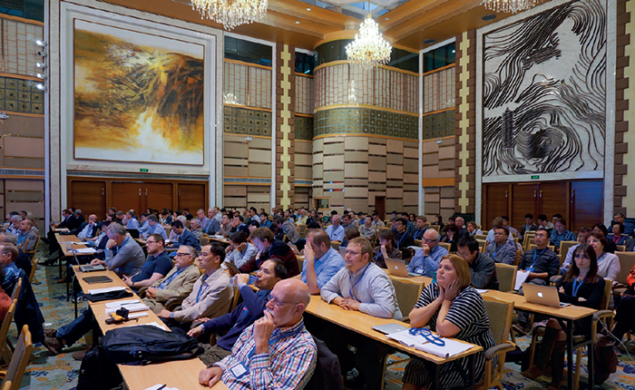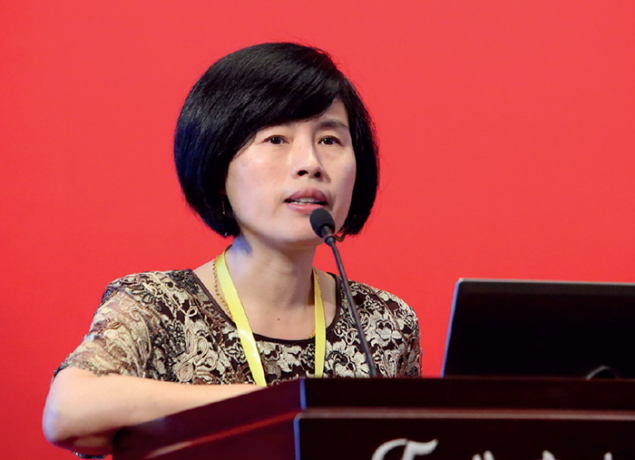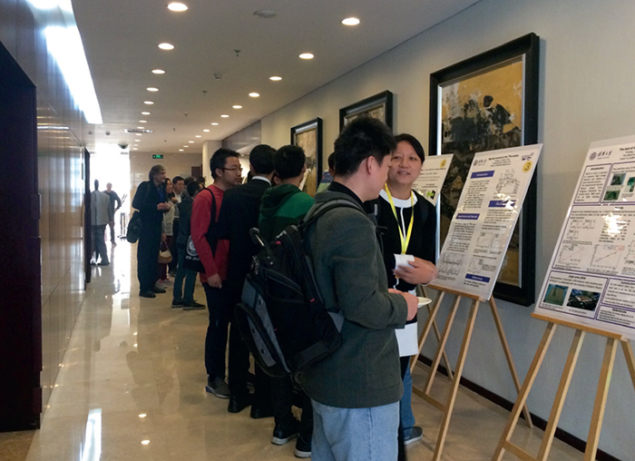A report from the International Symposium on Spin Physics.

Image credits: SPIN2014 organizers.
The biannual series of international symposia on spin physics plays a leading role at the interface of nuclear and particle physics on one hand, and the study of spin-dependent phenomena in experiment and theory on the other. The series grew from the merger of the five-yearly symposia on polarization phenomena in nuclear reactions, first held in Basel in 1960, and the symposia on high-energy spin, which started in 1974 and had reached the 13th edition by 1998. The joint meetings began as the 14th International Symposium on Spin Physics in 2000. The 21st International Symposium on Spin Physics (SPIN2014) is the first in the series that China has hosted – taking place on the 40th anniversary of the first high-energy spin meeting at Argonne National Laboratory in 1974.
The scientific programme of the symposium series today is based on physics with photons and leptons, spin phenomena in nuclei and nuclear reactions, and new physics beyond the Standard Model. It also includes new technologies related to accelerators, storage rings, polarized targets and polarized beams, and spin physics in medicine is also included. In addition, SPIN2014 extended the topics to incorporate spin in condensed matter, quantum communication and their related applications.
Hosted by Peking University, Beijing, and supported by many renowned research institutions and universities, both inside and outside of China, SPIN2014 took place on 20–24 October 2014. Nearly 300 participants attended from more than 20 countries. With 28 plenary talks and 177 parallel talks, the symposium provided a platform to communicate new results in the field of spin physics and to reinforce academic collaborations with colleagues. It was also an important platform to advertise the academic achievements of Chinese researchers, and to strengthen the importance of Chinese involvement in spin physics. The following gives an overview of the scientific programme.
Hadrons, nucleons and symmetries
A key highlight was the excellent opening plenary talk on the spin structure of the nucleon by Xiangdong Ji of Shanghai Jiao Tong University and the University of Maryland. The quest to determine the origin of nucleon spin challenges the understanding of QCD. There is a worldwide experimental programme underway using spin observables to gain insight into this fundamental question in hadronic physics. The conference also heard more than 50 reports from experiments carried out at Brookhaven, CERN, DESY, Jefferson Lab and KEK on measurements that included inclusive lepton scattering (quark and gluon contributions), proton–proton scattering (gluon contribution, quark flavour decomposition using W-boson production), semi-inclusive deep-inelastic scattering (quark flavour decomposition, transverse-momentum distributions), deeply virtual Compton scattering (quark orbital angular momentum) and fragmentation in electron–positron collisions. There were also discussions on future possible experiments, including polarized Drell–Yan scattering, at Fermilab, the Japan Proton Accelerator Research Complex, the Nuclotron-based Ion Collider fAcility (NICA) in Dubna, and Brookhaven’s Relativistic Heavy-Ion Collider (RHIC). Keh-Fei Liu of the University of Kentucky gave an overview of the exciting developments in lattice QCD in a plenary talk. This was followed by more than 20 presentations on theoretical research into the spin structure of hadrons.

The plenary programme on “Spin Physics in Nuclear Reactions and Nuclei” included a report by Andro Kacharava from the Forschungszentrum Jülich on results from the Cooler Synchrotron (COSY) on nucleon–nucleon scattering using polarization degrees of freedom to probe nuclear forces. Mohammad Ahmed of North Caroline Central University described the latest results on few-body reactions from the High Intensity Gamma-Ray Source Facility at the Triangle Universities Nuclear Laboratory, where both polarized beam and polarized targets were employed, as well as results on Compton scattering from 6Li and 16O. Fifteen talks in the parallel programme were related to spin physics in nuclear reactions and nuclei.
Spin physics plays an important role in studies of fundamental symmetries
Spin physics plays an important role in studies of fundamental symmetries and searches for new physics beyond the Standard Model of particle physics. Plenary talks included reports on the latest result on the weak charge of the proton from parity-violating electron scattering by Dave Mack of Jefferson Lab. Mike Snow of Indiana University presented recent results on hadronic parity-violating experiments such as np → dγ, while Brad Filippone of Caltech provided an overview of the worldwide effort on searches for particle electric-dipole moments (EMDs). Frank Maas described the latest results on dark-photon searches from the University of Mainz and elsewhere. From China, Wei-Tou Ni of National Tsinghua University discussed the role of spin experiments in probing the structure and origin of gravity. Thirteen talks relating to fundamental symmetries were presented in the associated parallel sessions.
Current tools and future facilities
The methods to study spin-dependent effects are fundamental for the spin-physics community. At SPIN2014, the two main areas of interest were acceleration, storage and polarimetry of polarized beams, and sources of polarized ion and lepton beams and polarized targets. Nearly all of these disciplines formed part of the exciting plenary of Annika Vauth of DESY, who discussed the status of beam polarization and the International Linear Collider that could be built in Japan. Nearly 20 parallel talks were devoted to accelerator aspects, among them studies in the US and in China on electron–ion colliders (EICs), at JINR on the use of NICA as a polarized-ion collider, on storage rings for searches for ion EDMs, and on the new tools to be developed to meet these challenges. The operation of existing rings with polarized beams and the steady improvement of their operational parameters were also covered, with RHIC and its amazing performance as the only double-polarized ion collider built so far, and with COSY, which is famous for its stored polarized beams in the medium-energy range and the variety of internal targets.
More than a dozen parallel talks on sources and targets were presented, introduced by Dmitriy Toporkov of the Budker Institute of Nuclear Physics in his plenary on experiments with polarized targets in storage rings, in which he showed the potential of this technique. The review on polarized sources by Anatoli Zelenski of Brookhaven and other parallel talks covered a wide span of polarized beams, from high-intensity electrons for an EIC, to protons, as in H– ions for RHIC, to deuterons for COSY and 3He ions for eRHIC. Chris Keith of Jefferson Lab and other speakers in the parallel sessions covered solid targets polarized by dynamic nuclear polarization or by the brute-force method in several lepton-scattering experiments. Gas targets for H, D and 3He atoms were also discussed.

The conference heard reports on major upgrades of spin capabilities at existing facilities. The status and plans for Jefferson Lab’s 12 GeV upgrade were presented in a plenary talk by associate director Rolf Ent, and Wolfgang Lorenzon of the University of Michigan described the possibility of polarizing the Fermilab proton beam and mounting a programme of polarized Drell–Yan measurements. In Europe, the Mainz Energy-Recovering Superconducting Accelerator provides a high-intensity low-energy polarized electron facility, while COSY has embarked on a major development of new polarized proton- and deuteron-beam capabilities, motivated by experiments to look for nonzero EDMs in light nuclei.
In the US, the QCD community is pursuing a high-luminosity polarized EIC
Alexander Nagaytsev of JINR described the new accelerator NICA under construction in Dubna, together with the planned spin-physics programme, including measurements of polarized Drell–Yan and J/ψ production. In the US, the QCD community is pursuing a high-luminosity polarized EIC. This could be implemented at Brookhaven or Jefferson Lab. The concept has driven R&D in both high-intensity polarized electron guns and a polarized 3He source. In the European Physical Journal A plenary lecture, Zein-Eddine Mezziani of Temple University gave a compelling presentation on the spin science that motivates this new machine. Physicists in China have recently become interested in a similar facility.
Further features
As a novelty, SPIN2014 included a significant programme on spintronics – low-dimensional solid-spin systems exhibiting different quantum effects that can be employed, for example, in quantum computers, metrology, information technology and more. This ambitious field of research and technology is being pursued actively at Tsinghua and Peking Universities, and many other Chinese institutes, and was presented in a public lecture (see below) as well as in parallel sessions that included 20 talks. Apart from spintronics themes, medical applications such as imaging were discussed, a highlight being the beautiful talk by Warren Warren of Duke University on “Imaging with Highly Spin-Polarized Molecules”. There were also two talks on the application of polarized fuel for fusion reactors.
Besides the communication of recent results at the physics frontier, SPIN2014 also organized a lecture on popular science by Qi-Kun Xue from Tsinghua University on “Quantum Anomalous Hall Effect and Information Technology”, attended by more than 100 people from Peking University, Tsinghua University, Beijing University of Posts and Telecommunications, Beihang University and others. A memorial session devoted to the memory of CERN’s Michel Borghini was organized by Alan Krisch of Michigan and Akira Massike of Kyoto, highlighting Borghini’s contributions to the development of solid polarized targets.
A poster session for presenting new research results included Outstanding Poster Awards, sponsored by the Hanscom endowment from Duke University. From 14 posters, three young researchers from the China Institute of Atomic Energy, Tsinghua University and the Institute of Modern Physics of the Chinese Academy of Sciences received awards. The hope is that the poster session and awards will inspire young researchers to work with passion in the area of spin physics. A reception and banquet, and a visit to the nearby Summer Palace, served to bring all of the participants together, enhancing close discussions. They will surely remember SPIN2014 as a stimulating meeting that demonstrated the beauty and vitality of the field – and look forward to the next in the series, which will take place on 26–30 September 2016 at the University of Illinois Urbana-Champaign.
• For more about the organizers and sponsors of SPIN2014, and details of the full programme, visit www.phy.pku.edu.cn/spin2014/.








